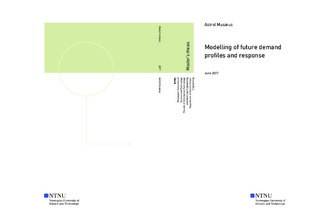| dc.description.abstract | The installation of smart metering systems to all electricity consumers in Norway, commissioned by NVE, is predicted to enable more active power consumers, due to a two-way communication of price and consumption information. A behavioral change in consumption is therefore expected, through the facilitation of \textit{Demand Response (DR)}.
The EFI's Multi-area Power-market Simulator (the EMPS model), is an important tool in Statnett's long-term market analysis, know for its ability to model and handle hydropower production. This thesis aims to evaluate ways to model DR within general consumption in the EMPS model. As the most straightforward way proved to be a change in the input demand profiles, new profiles were created for 2030. These were collected from another model, the Leopard model, a tool developed for Statnett to project future consumption and its annual distribution. Here, the demand profiles for residential consumption are optimized to even out daily consumption, thus imitating DR. The primary sector and the service sector were provided with non-flexible demand profiles.
Five cases have been developed and evaluated to test the new profiles, differing in their way of modelling firm demand. Three cases were provided with the new profiles, in addition to the new, projected consumption volumes applied in all cases. In the analysis, the three Leopard cases were compared to the original, non-flexible modeling of the 2030 power system, based on their change in consumption, prices, cross-border power exchange, socioeconomic benefits and profitability to the consumer. Even though all cases showed overall reductions in peak hour consumption and average prices, only one case yielded positive economical results to the consumer and to society. In this case, a finer resolution of general consumption was introduced, in addition to the extraction of non-temperature dependent flexible household demand, namely heating of water and charging of electrical vehicles. This way of modeling, combined with the change in temperature dependency proved to be the most beneficial in regards to demand response.
Even though positive results were seen in one of the cases, more thorough ways of modelling demand response should be evaluated, with a price based optimization. Additionally, all segments within consumption should be evaluated, as the potential for DR is not exclusively isolated in the residential sector. However, with a more active power consumer, a need for more frequent updates of the demand profiles might evolve. Therefore, Statnett should consider the implementation of demand profiles projected in the Leopard model, in addition to the projected annual consumption quantities. | |

